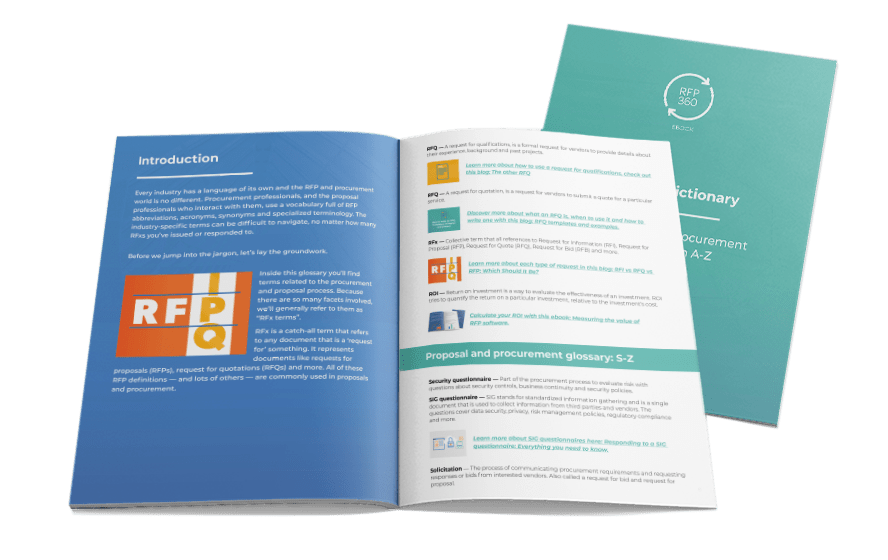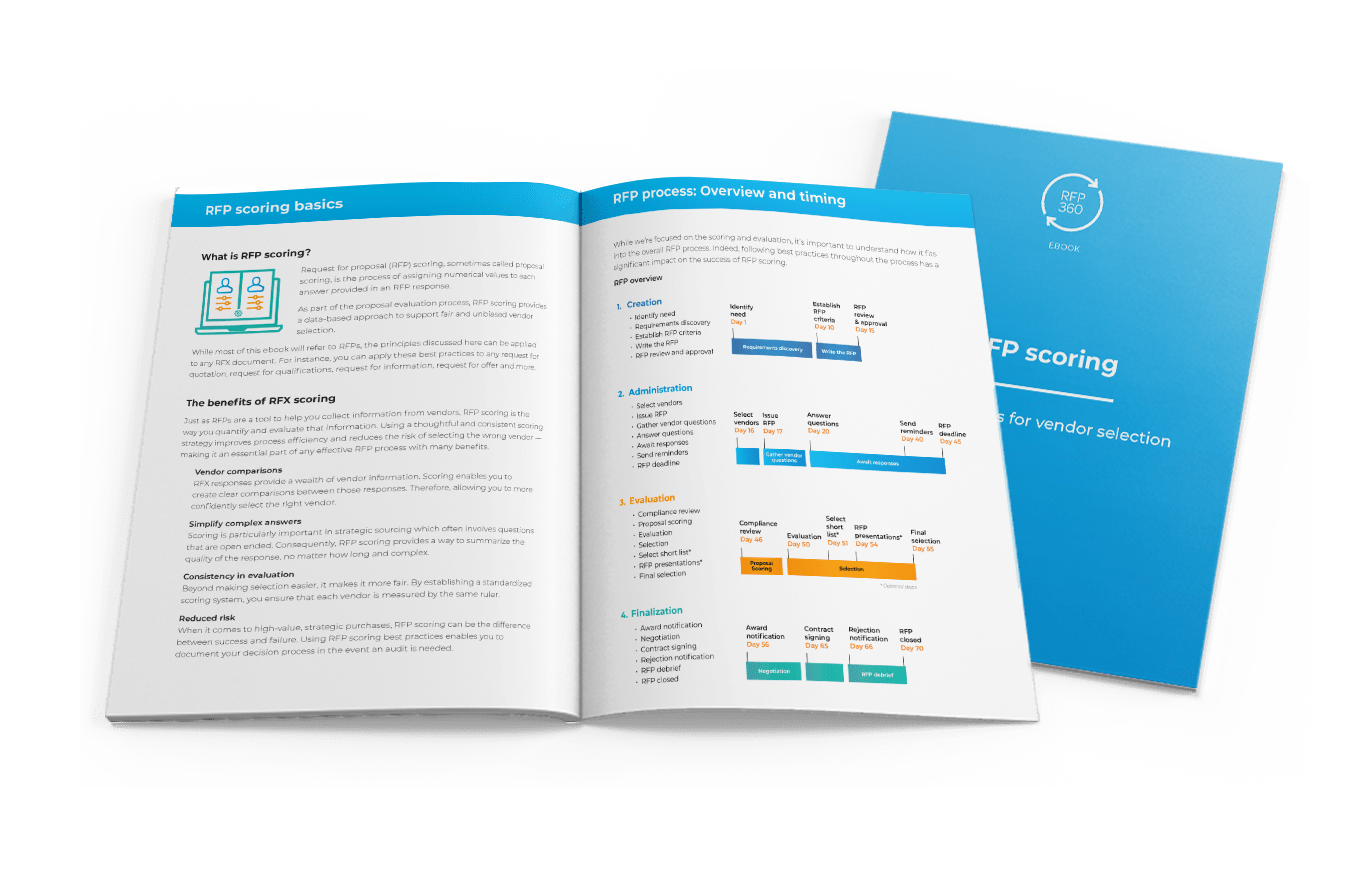Deciding to invest in an information technology (IT) service or product is stressful. Granted, it’s usually a big purchase and the expectations are high. You have to evaluate dozens of factors including data security, implementation time frames and industry expertise. Naturally, there’s a lot of pressure to get it right. Luckily, a thoughtful IT RFP can help you make a data-based, strategic choice.
In this blog, we’ll explore everything you need to know about creating an effective RFP for technology. From key terminology and definitions to simple steps you can take to identify a vendor who meets all your requirements, you’ll find what you need here. Finally, we’ll offer RFP examples and a template to help guide you through the process.
Table of Contents
- Key IT sourcing terminology
- 3 simple steps for effective IT RFPs
- An overview of the RFP for IT services process
- IT RFP examples and template
Key IT sourcing terminology
Before we jump into how to write an IT RFP, let’s go over some key definitions and terminology often used for technology procurement.
What is IT sourcing?
IT sourcing is the process of selecting an external information technology solution. The strategic sourcing process evaluates an IT solution’s useability, technical capabilities, security and customer resources.
CIO Index describes the importance of strategic IT sourcing saying:
“With a fast changing global economy and evolving business objectives it has become essential for CIOs and IT Managers to create a strategic sourcing plan where the relationship with the vendor would be one of collaboration; ensuring their capability to respond to the organization’s changing business needs in order to deliver value.”
ROI
Return on investment (ROI) is the value delivered by a solution. Throughout the information technology RFP process, ROI should be a top priority. Consequently, vendors that also focus on your ROI are more likely to deliver it.
For more information about software ROI, download the ebook: Measuring the value of RFP software.
RFI
An IT request for information (RFI) explores the market. When faced with a challenge, an IT RFI presents the problem and asks for vendors to offer their best solution. Generally, creative and innovative proposals are welcome. The RFI doesn’t necessarily lead to a future purchase, but it can inform your solution planning and RFP creation.
An article about IT sourcing from Consultancy.org provides this insight about an additional benefit of including an RFI in your process:
“The traditional precursor to the RFP process, the Request for Information (RFI), is used to create a shortlist of recipients for the RFP and to provide the customer with strategic options for sourcing and network architecture.”
RFP
An information technology request for proposal (RFP) is more formal than an RFI and asks specific questions. Generally, the RFP will also include background information about the problem and how the business expects vendors to meet their needs. When an vendor receives an RFI, it indicates that a purchase is imminent. Certainly, the questions in the RFP should reflect the company’s priorities.
Common IT RFP questions may include:
- Technical and functional requirements
- Client references
- Customer success and support
- Onboarding and training process and timeline
- Data security and service level agreements
- Pricing models including any user and data limits
Security questionnaire
A security questionnaire is a document that asks about a vendor’s security policies. It seeks to establish trust between a customer and IT vendor. Sometimes it is referred to as a third-party risk assessment, vendor risk assessment, vendor security assessment or SIG questionnaire. Certainly, the security questionnaire is a vital part of any software or technology procurement process. Not only is it included in the IT sourcing process, but it is also issued annually to ensure ongoing security compliance.
A security questionnaire covers:
- Security audits and penetration testing
- Internal security practices and policies
- Personnel policies, hiring practices and training programs
- Security certifications
- SLAs and uptime vs. downtime
- Web application security
- Physical and datacenter security
- Infrastructure security
- Business continuity
For a full procurement glossary, check out this blog post: RFP and RFx definitions: A procurement glossary from A-Z

3 simple steps for creating effective IT RFPs
1. Determine why you’re issuing the RFP (and if it’s the right tool)
Make sure you have a clear understanding of what you’re trying to accomplish by sending out a technology RFP. RFPs are typically formal and time intensive. They are best leveraged when you’re ready to make a purchase, know what you want to accomplish and are open to vendor’s suggestions on how to solve your problem. However, you may have other reasons for issuing an RFP for IT services.
According to TechTarget, it’s likely one of three reasons:
- You’re trying to get a better bid from your preferred provider
- It’s a company protocol
- You’re trying to get ideas so you can solve the problem in-house
If any of those options sound familiar, an RFP might not be your best way forward. If you’re just trying to get a better bid, go with a request for quotation (RFQ) instead. Alternatively, if you’re just looking to see what’s available but you’re not certain you want to make a purchase, consider sending a brief request for information (RFI).
If you do issue an RFP, keep it short. (Use multiple rounds, if necessary.) And ask the deal-breaker questions upfront, so you can quickly narrow down your options, saving both you and your vendors a whole lot of time.
For an infographic guide to RFx selection, download the RFI, RFP, RFQ selection guide.
2. Learn from those who have issued similar information technology RFPs
Avoid reinventing the wheel when developing your RFP by first finding a good template and following best practices. Explore how other organizations have handled similar RFPs. This insight gives you a great place to start, and can also expose holes in your own search criteria. Check out the templates and examples below.
RFP insights from healthcare IT
There’s a lot of great information available about IT sourcing in specific industries. Luckily much of it can be applied to almost any industry. For example, below are some of our favorite bits of wisdom from the healthcare industry.
“Secure upper management buy-in and funding … funding for technology often goes beyond the initial purchase. Depending on the model, you may have annual subscription fees after the initial implementation and setup. Or there could be maintenance and upgrade fees you need to consider down the line. Knowing fee structures and cost components during the RFP process can be a jumping off point for setting budgets for an organization.” — 5 Keys to a Successful Healthcare IT RFP
“Structure your RFP timeline so both you and the vendors have appropriate time at each step of the process. If you rush the responses, you risk receiving answers that are not well thought out. Depending on the complexity and scope of the project, a good rule of thumb is to give vendors at least three to four weeks to respond. — 4 Keys to Keep Your RFP Process as Painless as Possible
“It is important to remember that the purpose of selecting a vendor and developing a solution is to provide the end users with technical capabilities that solve a business issue. The RFP should focus on these capability requirements.” — 4 Best Practices for a Successful Healthcare IT RFP Process
3. Include the critical factors in your RFP
Once you’ve seen some examples of similar RFPs and gathered the product and service-specific criteria, you’re ready to write your RFP.
Remember to:
- Clarify your organization’s storage standards for on-premise vs. cloud storage
- Identify your security requirements
- Read vendor case studies. Do the testimonials demonstrate how they can solve your challenges?
- Research how vendors provide customer service. For example, is it automated or only available during certain hours?
- Look at the vendor’s competitors. If you can’t tell who they are, feel free to ask them directly
- Read vendor ratings on websites like Capterra and G2
An overview of the RFP for IT services process
Strategic sourcing for IT solutions should be a multi-step process, rather than a single step of just issuing your IT RFP. Admittedly, not all of the steps listed below are required for a successful project, certainly they can all be helpful.
1. Identify your business challenge
Collaborate with stakeholders and internal teams to define the problem they’re facing. Ask for suggestions about what the ideal solution would look like. Begin gathering requirements, background, goals and needs. Some organizations us a business requirements document or functional requirements document to organize their needs.
2. Explore your options
Issue an RFI to explore the market. Consider casting a wide net for this step to ensure you have a solid understanding of all available options.
3. Create and issue your RFP
Be sure to include background information, the goals you established, your implementation timeline and a request for references.
4. Proposal evaluation
Compare vendors and evaluate responses. Be sure to involve stakeholders with relevant expertise. Remember, weighted scoring can make your choices much more clear.
5. Select your shortlist vendors
Use your scoring results to select your shortlist. Don’t forget to consider ability to execute, their track record of success and ability to scale.
6. Security questionnaire
While some businesses prefer to send the security questionnaire with the RFP, consider sending it after you’ve selected your shortlist to avoid asking vendors who aren’t a fit to do unnecessary work.
7. Request demonstrations
Now that you’ve selected your shortlist and verified their security is sufficient, it’s time to see it in action. So, schedule your RFP presentations.
8. Final vendor selection
Hopefully at this point, you have a clear idea of who the best choice is. Using the RFP, build a contract and set your plans for implementation.
IT services RFPs are like any other. So, it’s important to follow RFP best practices when creating them. Explore this guide for more information about how to create a consistent, effective and efficient RFP process.
The RFP process guide ebook

IT RFP examples and templates
CRDF Global IT RFP example
CRDF Global is a nonprofit organization with an IT Director and two software developers. So, when they needed general IT support, they issued this thoughtful RFP for IT services that offered excellent background information, clear evaluation criteria and required services. It’s a great example of an effective IT RFP.
Technology RFP example |eProcurement Solution and Implementation Services
This RFP from the State of Vermont details the agency’s need to streamline the procurement process for their education system. In addition to the RFP for technology and professional services example, you’ll also find a sample bidder form and additional information here.
DP Solutions IT RFP template
This information technology request for proposal template is a Word document provided by DP Solutions, an IT service provider. If you ask, many vendors will happily provide you with an RFP for technology template to use. However, if you use one of these templates, remember to customize it and ensure that your final RFP isn’t biased to favor the company who provided the template.
State of North Carolina information technology RFI template
The State of North Carolina’s information technology department offers a catalog of useful templates and reference materials. Helpfully, their documents include an IT RFI template that can easily be adapted for use by any organization.
Final thoughts on RFPs for IT services
Key takeaway: Remember, make sure your RFP will actually achieve your objective. Consider that there might be a simpler, quicker way to find the information you need (RFQ, RFI, etc.). Finally, if you do go with an RFP, do your homework, look for tips and examples, and make sure you’ve included all the critical criteria.
Additional resources:
- Top RFP questions to ask your team and vendors
- Difference between an RFI, RFP, and RFQ
- How to do RFP weighted scoring
Still feeling overwhelmed?
Request a demonstration to learn how RFP360 can help you streamline the RFP process.
Originally published on January 13, 2017 — Updated February 16, 2023



